The Yangtze River Basin in China has witnessed several summer droughts since 2000, with typical hits in 2006, 2013, and 2019. Droughts in the Basin are generally becoming recurrent and more frequent, with the drought in 2022 being another severe and long-lasting one. This article presents the analysis of IWHR experts upon the current situation, characteristics, impacts and development trend of this drought, and their suggested countermeasures for drought relief.
Drought conditions in the Yangtze River Basin
As one of China’s most important water systems and the third largest river in the world, the Yangtze River drains a total area of 1.8 million square kilometers, which accounts for about 18.8% of China’s land area. Most areas of the Yangtze River Basin, which sees an average annual precipitation of 1,067mm, are featured with humid or semi-humid climates.
Despite the abundant rainfall and river flow, the area has been struggling with frequent and large-scale droughts in recent years. Starting from July 2022, precipitation in the Yangtze River Basin has been much less than normal while heatwaves have prolonged. In general, abnormal atmospheric circulation is the primary course of this year’s large-scale drought in the Yangtze River Basin.
Defective plum rain and typhoons this year have led to a sharp reduction in precipitation in the Yangtze River Basin. Plum rains lasted short this summer and were even absent in some areas. Also, regular typhoons in July and August failed to reach the inland and trigger an obvious increase in precipitation.
Latest monitoring of the National Climate Center of China showed a 40% drop in post-July precipitation in the Yangtze River Basin, compared with the same period of past years. Such drop was even sharper– 50%-70% – in the Poyang Lake (along the middle and lower stream of Yangtze) and the Jialing River (an upstream tributary of Yangtze River). There has been no effective rainfall for over 20 days in some areas.
Precipitation anomaly in the Yangtze River Basin was basically above -50% in July, but it fell to -80% in the eastern part of the Basin by August. The precipitation of the entire Basin fell below 50mm, and the post-August cumulative precipitation upstream was even below 1mm, leading to rapid progression of drought in the Basin in August.
Meanwhile, heatwaves had lasted for more than 15 days since July in most part of the Basin, over 25 days in the middle-reach and downstream areas, and over 30 days in the northern Anhui Province and northwestern Hubei Province.
Hot and sunny days with high temperatures affected vast areas in the Basin. The National Meteorological Center of China issued high-temperature alerts for 23 consecutive days from July 21 to August 12. Sichuan Province, Chongqing Minicipality and Hubei Province, all located downstream of the Yangtze River, saw unprecedented high temperatures in early August. The temperature of Chongqing soared to above 40°C during August 9 to 11 and remained at that level for seven days, breaking the local temperature record. The average monthly temperature in the upstream area of the Basin, except for most areas of Jiangxi Province, rose to above 28°C.
Temperature anomaly rose to another high in August. The eastern Sichuan and most areas of Chongqing saw that value at 4~6. Continuous high temperature is the main contributor to the rapid deterioration of drought in August.
Meteorological forecasts indicated high temperature and insufficient precipitation would last for one week in most of the Yangtze River Basin, and drought in Sichuan, Chongqing, Hubei, Hunan, Anhui and Jiangxi might worsen.
In terms of hydrological situation, the water levels of the Yangtze River, as well as the Dongting Lake and the Poyang Lake, fell to 4.7~5.7 meters below normal, all hitting record low of water level in August. While water reserves in large- and medium-sized reservoirs in the Basin were mostly abundant, serious water shortage was seen in some small reservoirs.
Characteristics of the 2022 Yangtze River Basin summer drought
(1) Large affected area.
Since July 2022, droughts have hit six provinces/municipalities in the Basin, namely Sichuan, Chongqing, Hubei, Hunan, Anhui and Jiangxi. Compared to summer droughts in the past, including the 2006 drought in the upper reaches of the Yangtze River, and the 2008, 2009, 2013, 2017, 2018, and 2019 droughts in the middle and lower reaches, the 2022 drought spans over the entire mainstream, from upper, middle to lower reaches, a relatively rare situation adding to the difficulties of emergency water dispatch.
The Ministry of Water Resources (MWR) of China is currently implementing a special action named Joint Operation of Reservoirs in the Yangtze River Basin to Fight Drought and Ensure Water Supply, sparing no efforts to mitigate drought and secure water supply with specific measures for targeted areas and groups.
(2) Early start and long lasting.
The 2022 drought in the Yangtze River Basin worsened rapidly in July and lasted about 40 days, as precipitation from mid-June onwards decreased amid a shorter flood season. Most of the Basin’s typical summer droughts started in mid-to-late July, peaked in around mid-August, and were usually alleviated by typhoon precipitation in late August, lasting a month or longer. The 2022 drought started roughly 20 days earlier compared to previous years, and would escalate significantly if no large-scale effective precipitation was seen in the drought-hit areas after mid-August.
(3) Great severity.
Precipitation in the Yangtze River Basin has been less since early June, compared to the same period in previous years, down by 20% in late June and 40% in July. The Yangtze mainstream and Poyang Lake river systems, in particular, endured a roughly 50%~70% decrease in rainfall.
Currently, the water level in the middle and lower reaches of the Yangtze River continues to decline, falling to far below its historical level. At the outflow control stations of the Yangtze mainstream, Dongting Lake, and Poyang Lake, water levels at 8:00 a.m. on August 11 were 5~6 meters lower than those in previous years, respectively hiting the second, third and forth historical low in August in history.
Amid drastically fewer precipitation, the Yangtze River Basin has been struggling with record-breaking temperatures. Heatwaves lingered over 15 days in most of the Basin, and even 25 days in some parts of the River’s middle and lower reaches.
In response to the severe drought, MWR launched a level-IV drought emergency response in six provinces/municipalities of the Yangtze River Basin at 12p.m. on August 11. This is the second drought emergency response in the Yangtze River Basin since the level-IV response activated by the Yangtze River Water Conservancy Committee on October 25, 2019.
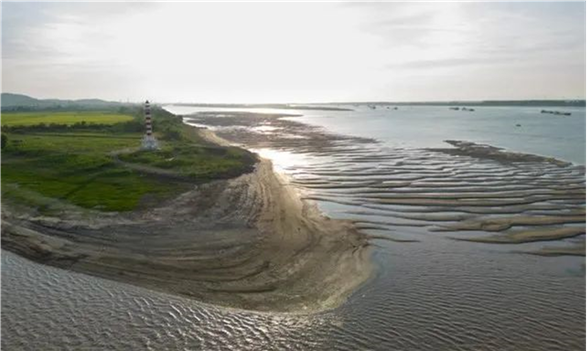
A large area of ??lake beaches are exposed recently at the intersection of Poyang Lake and the Yangtze River in Jiujiang city, Jiangxi Province (Source: CCTV)
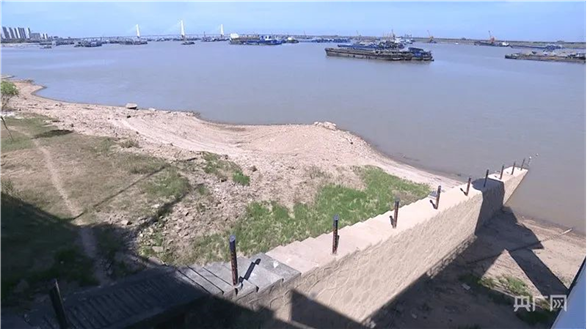
Dongting Lake in its dry season (Source: CCTV)

The large beach at Nan'anzui Corner, Wuhan city, was exposed due to plummeted water levels resulted from high temperatures and low rainfall (Source: Chutian Metropolis Daily)
Impacts of the 2022 Yangtze River Basin summer drought
Some impacts of the 2022 Yangtze River Basin summer drought on agriculture, drinking water for humans and livestock, and ecosystems in provinces and municipalities in the Basin have been seen as of mid-August.
(1) Agricultural production.
In southwest China’s Sichuan, Chongqing and several other provinces/municipalities, single-cropping rice has begun to fill grains, most at the milk development or ripening stage and a few undergoing stem elongation or anthesis. During this period of time single-cropping rice is most sensitive to temperature and water, the continuing serious lack of rainfall and moisture has led to a decrease in the rate of fruiting, undermining rice yield.
In the south Yangtze River and some parts of south China, in August, single-cropping rice was mostly at the jointing or booting stage, with some early-maturing varieties already going through stem elongation, anthesis, milk development or ripening. Double-cropping late-maturing rice was going through tillering.
Impacts of heat were evident, with the persistent high temperatures accelerating the ear differentiation and affecting the formation of large ears. Also, continuing high temperatures of above 38°C after the top-second leaf emerged from growing rice were likely to cause spikelet degeneration of some varieties.
Negative impacts were especially seen on the rice during the stem elongation and anthesis, as lasting high temperatures above 35°C may substantially reduce the rate of fruiting.
By mid-August, water sources had been effectively secured for most of the large- and medium-sized irrigation areas, but drought conditions were serious in some rainfed farmlands and regions far away from headwaters of irrigation channels.

(2) Drinking water for human and livestock.
Decentralized water sources, including small reservoirs, mountain springs, and streams, have seen depleted storage as a result of persistent high temperatures and rainfall deficit. Some people in drought-hit areas struggled with insufficient water supply, and some needed extra water delivery to secure their living.
According to MWR, as of August 11, drought has impaired the water supply for 830,000 people and 160,000 large animals across six provinces (municipalities) of the Yangtze River Basin.
However, the recent ten years have witnessed a significant improvement in access to drinking water for people and livestock during drought spells, thanks to the water conservancy projects and water supply projects constructed. The Bulletin of Flood and Drought Disasters in China revealed that the number of people in the Chongqing municipality suffering from drinking water scarcity during the 2006 Sichuan-Chongqing drought once reached 8.2 million, equivalent to 27% of the city's population, and 1.47 million of them had to rely on extra water delivery for their basic needs. That number increased at an average rate of about 50,000 people per day at the height of the drought. In Sichuan Province, meanwhile, a total of 7.17 million once lacked access to drinking water due to the drought, with 1.35 million relying on extra water delivery.
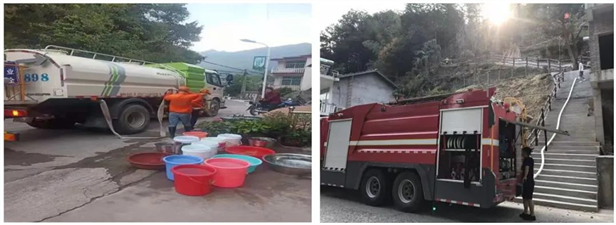
Emergency water supply Hunan Province in response to the 2019 drought (Data source: Department of Water Resources of Hunan Province)
(3) Eco-environment.
Satellite remote sensing images from 1982 to 2022 were used to analyze the impact of the 2022 drought on eco-environment in provinces including Sichuan, Hunan, Hubei, Jiangxi and Anhui and the Chongqing municipality in the Yangtze River Basin.
Impacts of droughts on territorial ecosystems have shown an upward trend with fluctuations during 1982–2022, noticeably after 2010. The impact on territorial ecosystems in the six provinces/municipalities in 2022 all reached or approached a record high during the January-July period.

Figure 1. Ecological drought conditions in the six provinces/municipality during April to July, 2022, analyzed by the author
The coverage of water bodies in ??the six provinces/municipality in the Yangtze River Basin have all reached or approached a record low during April to July in 2022, based on the analysis of the year-on-year data in the recent two decades.
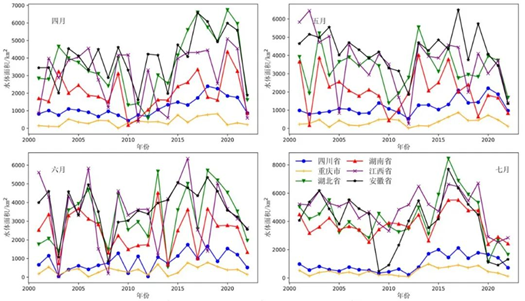
Figure 2. Area of water bodies in the six Yangtze River provinces/municipality during April to July from 2001 to 2022, based on the analysis of the author
Water levels of Poyang Lake and Dongting Lake kept declining to record lows as 4.7–5.7m below normal with the persistent drought, especially since August. A large area of lakeshores was exposed while grass swamps and shoals expanded, turning lakeshores into vast "grassland". That has not only undermined aquacultural and agricultural production but also damaged the ecosystems of the lake area.
In addition, according to relevant research findings, Poyang Lake’s dry season began nearly one month earlier, from early November during 1959–2002 to early October during 2003–2012. The dry season saw a significant extension from 77 to 111 days, lasting for 34 days longer than in the past. In 2022, Poyang Lake’s dry season came about 90 days ahead of time compared with 2003–2012, the earliest since record keeping began in 1951.
Possible future progress of the ongoing drought
Meteorological forecast of precipitation anomaly from August 1 to September 1 showed that precipitation would still be less than in average years in provinces/municipalities in the middle and lower reaches of the Yangtze River, down by 20%–50% in Hubei, Hunan, Anhui, Jiangsu, Zhejiang, and most of Shanghai and by 10%–20% in Sichuan and Chongqing.
Nationwide soil moisture forecast on a 10-day scale revealed that an extremely severe lack of soil moisture would be seen in Sichuan, Chongqing, Yunnan, Guizhou and Hubei in the upper and middle reaches of the Yangtze River. A severe lack of soil moisture was expected in the middle and lower reaches.
According to the European Centre for Medium-Range Weather Forecasts (ECMWF) forecast made during August 13–27, the Yangtze River Basin would still see no obvious rainfall in the first half of September. In the current context, the drought was likely to linger and deteriorate.
Such a large-scale drought is mainly subject to the atmospheric circulation of main climate systems. Objectively, it is difficult to predict when things will go back to normal, therefore preparations for a prolonged drought are necessary. Early investigation of water shortage in drought-stricken areas, scientific operation of water conservancy projects and implementation of drought control plans should be involved to ensure drinking water safety, meet water demands of large animals and secure seasonal irrigation for crops.
Suggested countermeasures
In a short-term response to the persistent drought, we should keep a close eye on weather changes, effectively enhance drought monitoring and early warning, and activating corresponding emergency response in a timely manner to ensure regulated drought relief.
We should strengthen integratd management and reasonable distribution of water sources we have in the Basin. Through overall drought relief planning and well-defined priorities, we should make the most of the limited water sources.
Areas stricken by the 2022 drought should draft emergency water supply plans that work for the most unfavorable circumstances from now until the next flood season in advance. Temporary drought-relief water source projects suitable to local conditions should be constructed to neutralize the risk of large-scale drinking water shortage.
We should provide supervision and guidance to a comprehensive investigation of the drinking water shortage of people in drought-hit areas. Emergency responses, such as extended pipeline networks, temporary water pickup sites and special water delivery, should be activated to secure domestic water use.
To address the grave challenges of frequent droughts in the Yangtze River Basin in the long run, a risk management model for drought disasters on all fronts is the most important. Appropriate efforts should be made based on careful consideration of local socioeconomic conditions and governance capacities while taking into account the extreme impacts and losses brought by potential severe droughts to life, production, and the eco-environment. With the primary goal of ensuring domestic water security and social stability, engineering and non-engineering measures should be deployed and advanced in a science-based and coordinated way to build a drought relief system.
(1) An appropriate drought relief engineering system centering on emergency water reserves should be built on the basis of making the most of existing water conservancy projects and comprehensively strengthening joint emergency drought relief.
An urban emergency reserve water sources system should be put in place, with a view to fostering a multi-type, multi-source water supply system.
Current rural emergency water source systems for emergency drought relief should be improved as appropriate based on the achievements already made under the National Drought Relief Plan. Small- and medium-sized reservoirs, water diversion projects, and spare wells for emergency drought relief should be added to such systems.
The construction of Five Types of Small-scale Water Projects (small-sized cisterns, pools, pump stations, reservoirs and water channels) in rural areas should be accelerated. Also, it is necessary to strengthen their connection with the continued construction and water-saving transformation of large and medium irrigation areas, drinking water safety in rural areas, and construction of water conservancy projects for small farmlands, so that synergies can be formed to more cope with drought-caused water shortages more effectively.

Water diversion project in Linchuan County, Jiangxi Province, 2014–2016
(2) Mechanisms for drought monitoring, forecasting, early warning and risk control should be improved.
A high-level and high-quality data-sharing network should be built for the compilation and integration of drought-related information, including meteorological, water conservancy, and agricultural data.
Drought monitoring and evaluation should be carried out as a routine to facilitate the early hydrological warning of droughts of rivers, lakes and reservoirs, while stepping up the research on mid- and long-term research on drought forecast and its business-oriented application.
A smart drought relief system covering the whole process of drought management should be developed. The system should integrate forecast, early warning, drilling and emergency plans for agricultural system, municipalities and ecosystem , in a bid to effectively support drought risk management with information technology.
(3) Improvements of drought mitigating capacities and resilience should be made.
Vulnerability to droughts can be comprehensively reduced by optimization of the overall economic structure and industrial pattern of regions.
Reasonable water consumption models should be promoted. A water pricing system that fully reflects water shortages and thus encourages water saving should be built.
An indicator system for controlling water use with reasonable water quotas for industries, control indicators for water efficiency improvement, and regulations for limited pollutant discharge to water function areas should be in place.
Water-saving agriculture, industries and the service sector should be developed to improve the efficiency and effectiveness of water resources.
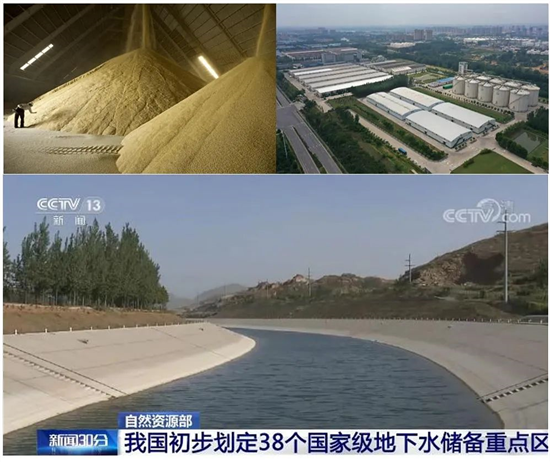
China gives high priorities to grain reserves and groundwater storage (Source: CCTV)
(4) Strategic preparations in advance for extreme droughts in the context of global climate change are of great importance.
Strategic grain reserves should be strengthened and strategic groundwater storage should be established for drought relief. Regulations, plans, and related working systems for drought relief should also be improved to meet new challenges under the new circumstances.
All sectors should be mobilized for drought prevention and relief. Drought-related knowledge dissemination and public education should be carried out, and a prudent insurance system is expected to play its part in reducing people’s loss in drought disasters. In that way, the capacities to respond to and recover from droughts, especially the extreme and exceptional ones, can be strengthened, and damages and losses caused by droughts can be prevented or mitigated.